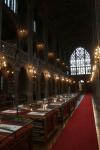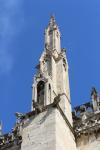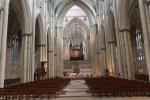Romanesque / Gothic
The term Romanesque, like many other stylistic designations, was not a term contemporary with the art it describes but an invention of modern scholarship to categorize a period. The term "Romanesque" attempts to link the architecture, especially, of the 11th and 12th centuries in medieval Europe to Roman Architecture based on similarities of forms and materials. Romanesque is characterized by a use of round or slightly pointed arches, barrel vaults, cruciform piers supporting vaults, and groin vaults. The great carved portals of 12th century church facades (see Church of St. Trophime) parallel the architectural novelty of the period-monumental stone sculpture seems reborn in the Romanesque.
Gothic architecture characterizes any of the styles of European architecture, particularly associated with cathedrals and other churches, in use throughout Europe during the high and late medieval period, from the 12th century onwards. It was succeeded by Renaissance architecture, a revival of Roman formulas, at varying times in Europe, beginning in Florence in the 15th century. A series of gothic revivals began in mid-18th century England, triumphed in the 19th century and continued, largely for ecclesiastical and university structures, into the 20th century.
The style emphasizes verticality and features almost skeletal stone structures with great expanses of glass, sharply pointed spires, cluster columns, flying buttresses, ribbed vaults, pointed arches using the ogee shape, and inventive sculptural detail. These features are all the consequence of a focus on large stained glass windows that allowed more light to enter than was possible with older styles. In order to achieve this, flying buttresses were used to enable higher ceilings and slender columns.
Gothic cathedrals could be highly decorated with statues on the outside and painting on the inside. Both usually told Biblical stories, emphasizing Old Testament prophecy and the New Testament (see Christian theology).








































































































